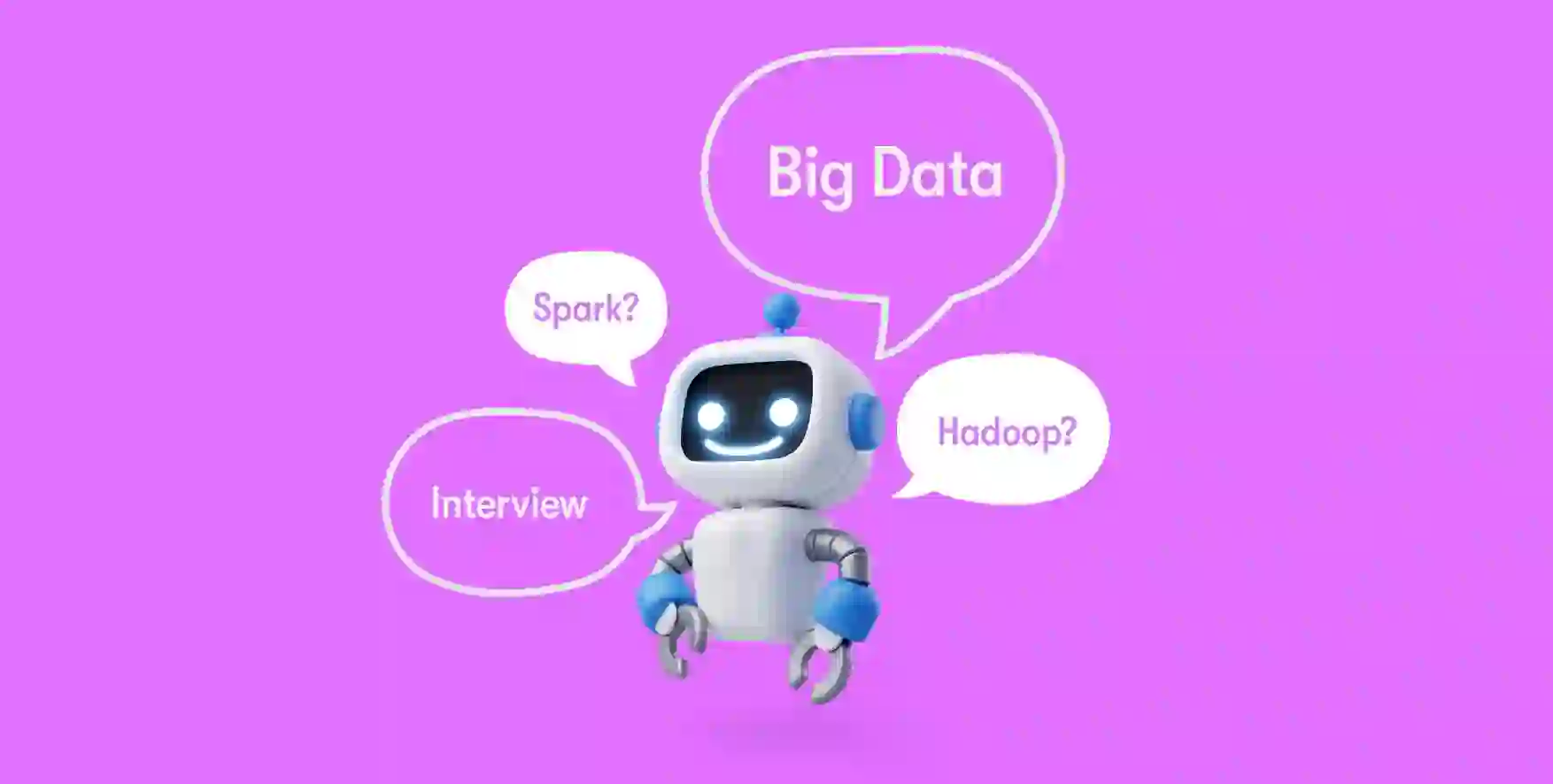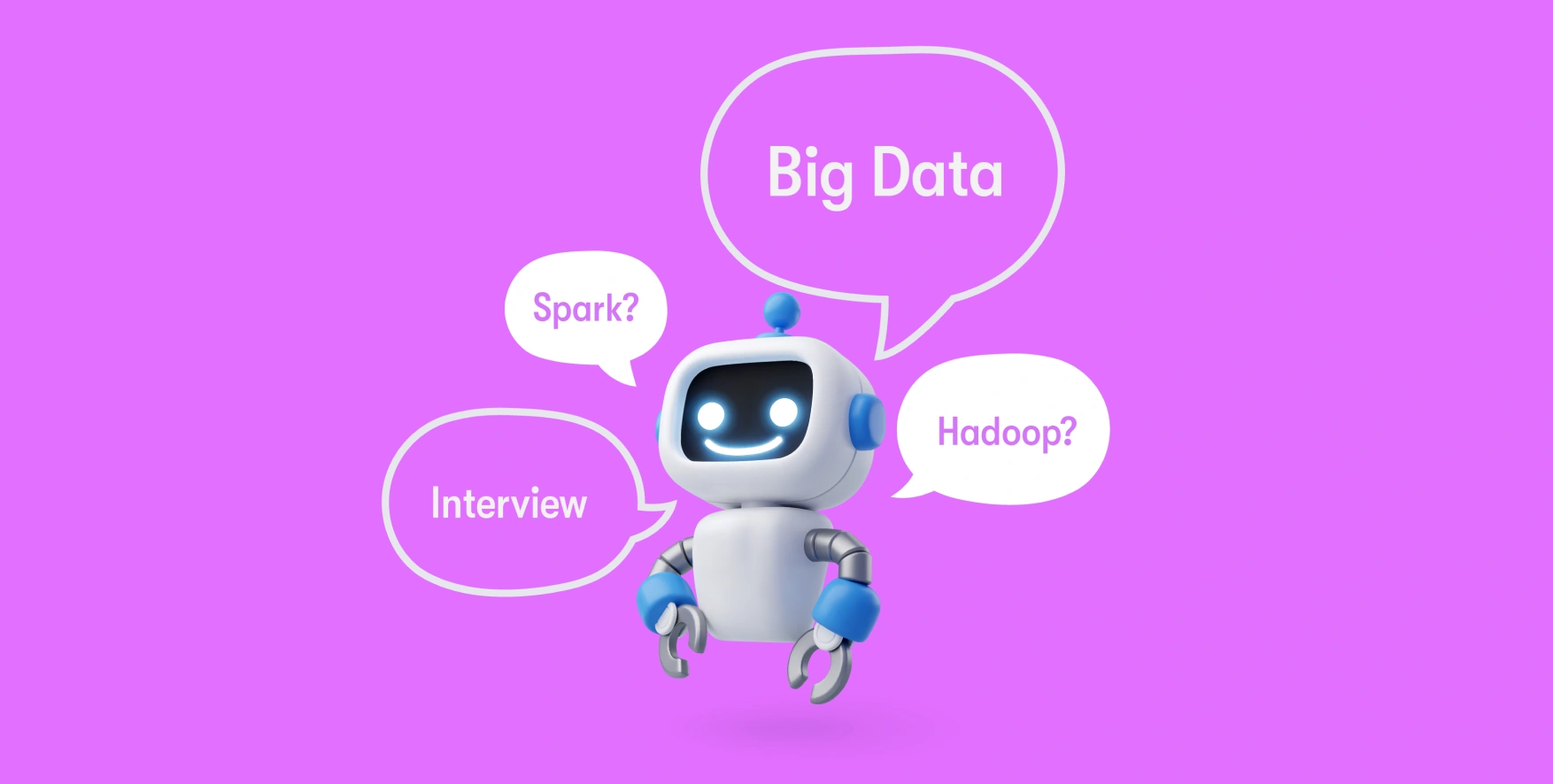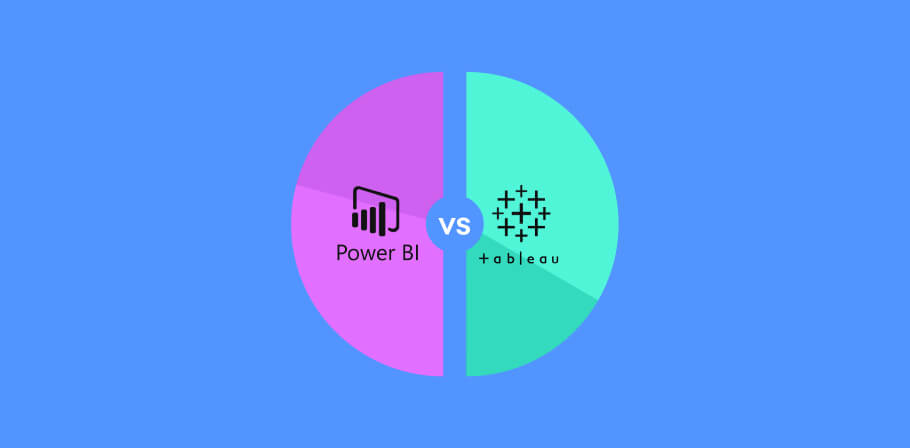These big data-related interview questions and answers have been reviewed and verified by Yury Paseishvili, Lead Software Engineer at EPAM. Thanks a lot, Yury!
Preparing for a big data developer interview can be time-consuming, requiring a deep knowledge of various technologies, concepts, and best practices in the rapidly evolving big data landscape. To help you present yourself perfectly at the interview, we have curated a list of 35 big data developer interview questions commonly asked by interviewers, covering topics such as Hadoop, Spark, NoSQL databases, data processing techniques, and more.
These big data engineer interview questions and answers are used to test your knowledge, skills, and experience in designing, implementing, and maintaining big data solutions. Reviewing these questions and their answers will enable you to showcase your expertise and land your dream big data developer job.
tired of job hunting?
Send your CV and we'll match it with our jobs while you get ready for your next big data interview.
1. What is big data, and why is it important?
The term "big data" refers to the enormous amount of structured and unstructured data that is generated from various sources like Internet of Things (IoT) devices and business transactions. This data is valuable for organizations because it enables them to make informed decisions, identify patterns and trends, and enhance operational efficiency by using advanced analytical tools to process and analyze the data. In today's digital era, big data has become a crucial resource for businesses, governments, and academic institutions to gain insights into consumer behavior, improve products and services, and drive innovation.
2. Explain the difference between Hadoop and Spark
Hadoop and Spark are two popular open-source frameworks used for big data processing. Hadoop is a distributed storage and processing system that uses the MapReduce programming model to process large datasets in parallel. It is designed to handle large datasets that are too big to fit on a single computer. The two main components of Hadoop are Hadoop Distributed File System (HDFS) used for storage and the MapReduce engine for data processing.
On the other hand, Spark is an open-source data processing engine capable of handling both batch and real-time data processing. Spark is faster than Hadoop because of its in-memory processing capabilities, which allow it to store data in memory and process it much faster than Hadoop. In addition, Spark supports multiple programming languages such as Java, Scala, Python, and R, making it more flexible than Hadoop in development.
Overall, both Hadoop and Spark are powerful tools for big data processing, but they have different strengths and use cases. Hadoop is better designed for batch processing of large data sets, while Spark is better for real-time processing and interactive analytics.
3. Describe the main components of the Hadoop ecosystem
The main components of the Hadoop ecosystem include:
- Hadoop distributed file system (HDFS): Applicable for storing large datasets.
- MapReduce: For processing large datasets in parallel.
- YARN (Yet Another Resource Negotiator): A resource management layer for managing and scheduling resources in a Hadoop cluster.
- HBase: A distributed, column-oriented NoSQL database for real-time read/write access to big data.
- Hive: A data warehousing solution for querying and analyzing large datasets using SQL-like queries.
- Pig: Used when creating MapReduce programs using a scripting language called Pig Latin.
- Sqoop: A data transferring tool used for Hadoop and relational database connections.
- Flume: Primarily used for collecting, aggregating, and moving large amounts of log data to HDFS.
4. What is data partitioning in big data analytics?
When it comes to handling large amounts of data, data partitioning can be an effective technique to speed up data processing and improve query performance. Essentially, data partitioning involves breaking down a massive dataset into smaller, more manageable parts known as partitions.
These partitions can then be processed in parallel, making the workload distribution in a computing environment easier. By doing so, big data analytics can achieve better scalability, improved fault tolerance, and faster processing times.
Moreover, data partitioning can also help to reduce network congestion and improve overall system performance by reducing the amount of data that needs to be transferred between nodes. All in all, data partitioning is a powerful tool in the big data analytics arsenal that can help organizations to process, manage, and analyze large datasets more efficiently.
5. Describe the CAP theorem in the context of big data systems
The CAP stands for Consistency, Availability, and Partition Tolerance — three attributes that describe the performance of a distributed data system.
Consistency means that all nodes in a distributed system show the same data at the same time. Any read request will return the most recent write, providing a clear and up-to-date view of the data. Availability refers to the system's ability to provide a response to any request, regardless of whether the system is in a failed or operational state. In other words, every request receives a non-error response. Partition tolerance means that the system continues to function even if there's a communication breakdown between nodes in the system.
The CAP theorem states that a distributed data system can only guarantee two out of these three attributes at any given time. This means that system designers must make trade-offs depending on their specific needs. For instance, if consistency and partition tolerance are vital, they might have to compromise on availability. Understanding these trade-offs is crucial for big data engineers as they design and maintain data management systems.
6. What is the role of a big data engineer?
A big data engineer is a professional who specializes in designing, developing, and maintaining complex big data solutions for organizations. They are responsible for handling vast amounts of data, ranging from terabytes to petabytes, and ensuring that the data is processed securely to enable effective decision-making.
Their primary task is to develop and implement data ingestion pipelines that extract raw data from various sources, like databases, sensors, and social media platforms. They then transform and clean the data to ensure data quality and consistency, and load it into a data lake or a data warehouse for storage and processing.
They also design and implement data processing workflows that handle the massive volume, velocity, and variety of data. This includes developing and tuning distributed computing systems, such as Apache Hadoop and Spark, to enable parallel processing of data across clusters of machines.
7. What are the key features of NoSQL databases?
NoSQL databases are non-relational databases for handling large volumes of unstructured or semi-structured data. Key features of NoSQL databases include:
- Schema-less data model: NoSQL databases do not enforce a fixed schema, allowing greater flexibility in storing diverse data types.
- Horizontal scalability: NoSQL databases can easily scale out by adding more nodes to the system.
- High availability: NoSQL databases often provide built-in replication and fault tolerance mechanisms to ensure data availability.
- Support for various data models: NoSQL databases can be classified into different types, such as key-value, document, column-family, and graph databases, depending on their data model.
8. What is data serialization, and why is it important in big data processing?
Data serialization is the process of converting data into a format that can be easily stored or transmitted and then reconstructed later. In the context of big data processing, serialization is used when data needs to be sent over the network or written to disk, typically in a distributed computing environment.
Serialization is important in big data processing for several reasons:
- Efficiency: Serialized data is usually in a compact binary format, which can be more storage- and network- efficient compared to text-based formats like JSON or XML.
- Interoperability: Serialization allows complex data structures to convert into a format that can be understood by different systems. This is crucial when working with distributed systems that may be written in different programming languages.
- Persistence: Serialization allows data to be persisted in a format that can be reloaded and used later. This is particularly useful in big data processing where intermediate results might need to be stored and reused.
However, it's important to note that serialization and deserialization can be computationally expensive processes. Therefore, the choice of serialization format and library can significantly impact the performance of a big data processing job.
9. Explain the concept of data shuffling in the context of big data processing
Data shuffling in the context of big data processing refers to the redistribution of data across the partitions of a distributed file system. This process typically occurs during the execution of certain operations in a distributed computing framework, such as Apache Hadoop or Spark.
In a MapReduce job, for example, data shuffling occurs between the Map and Reduce phases. The Map function processes the produced key-value and input data pairs. These pairs are then shuffled, meaning they are sorted and transferred across the network so that all pairs with the same key end up at the same reducer. The Reduce function then processes each group of values associated with the same key.
Data shuffling is a critical but resource-intensive part of distributed computing. It can significantly impact job performance due to the network overhead of transferring data between nodes. Therefore, optimizing the shuffling process is often a key consideration in big data processing.
Senior big data engineer interview questions
10. What are the main challenges in big data processing, and how can they be addressed?
The main challenges in big data processing include:
- Data volume: Handling large amounts of data requires efficient storage, processing, and analysis techniques. Solution: Use distributed storage and processing frameworks like Hadoop and Spark and adopt data compression and partitioning techniques.
- Data variety: Dealing with diverse data types and formats can be complex. Solution: Use schema-less NoSQL databases and data integration tools like Apache Nifi and Talend.
- Data velocity: Processing real-time data streams can be resource-intensive. Solution: Use stream processing frameworks like Apache Kafka and Apache Flink for real-time data processing.
- Data veracity: Ensuring data quality and being crucial for reliable analytics.
- Data security and privacy: Protecting sensitive data and complying with regulations is essential. Solution: Use data encryption, access control, and data masking techniques, and follow best practices for data governance.
11. How do you optimize the performance of a big data processing job?
To optimize the performance of a big data processing job, consider the following strategies:
- Use the right data structures and algorithms for the specific problem.
- Optimize data partitioning and shuffling to minimize data movement and network overhead.
- Leverage data caching and in-memory processing to reduce I/O latency.
- Use parallel and distributed processing techniques to improve resource utilization and throughput.
- Monitor and tune system resources, such as CPU, memory, and disk usage, to avoid bottlenecks.
- Optimize data storage formats and compression techniques to reduce storage and processing overhead.
- Use profiling and benchmarking tools to identify performance bottlenecks and optimize code.
12. Explain the Lambda architecture and its components
The Lambda architecture is a big data processing architecture that combines batch and real-time data processing to provide a scalable and fault-tolerant solution for handling large datasets. It consists of three main components:
- Batch layer: Responsible for storing and processing historical data using batch processing techniques. It provides accurate and comprehensive analytics results but may have high latency due to the nature of batch processing.
- Speed layer: Responsible for processing real-time data streams and providing low-latency analytics results. It may not provide complete or accurate results but can deliver insights quickly.
- Serving layer: Responsible for merging the results from the batch and speed layers and providing a unified view of the data for querying and analysis.
13. Explain the difference between a star and snowflake schemas in data warehousing
Star schema involves a central fact table connected to dimension tables via foreign keys. It's denormalized and faster, but may have redundant data.
Snowflake schema is a variation of star schema with normalized dimension tables split into related tables. It's more complex, slower but saves storage and enhances data integrity.
Read more about schemas in our senior data engineer interview questions.
14. How do you ensure data quality in a big data project?
To ensure data quality in a big data project, follow these best practices:
- Define data quality metrics and requirements, such as accuracy, completeness, consistency, timeliness, and uniqueness.
- Implement data validation and cleansing techniques to detect and correct data errors and inconsistencies.
- Use data profiling tools to analyze and monitor data quality over time.
- Establish data governance processes to ensure data quality and compliance with regulations.
- Collaborate with data producers, consumers, and other stakeholders to identify and address data quality issues.
15. What are the key data storage and management considerations in a big data project?
Key considerations for data storage and management in a big data project include:
- Data volume: Choose storage solutions that can scale horizontally to accommodate large datasets.
- Data variety: Use flexible data storage formats and databases to handle diverse data types and structures.
- Data velocity: Opt for storage solutions that support real-time data ingestion and processing.
- Data durability and availability: Implement data replication and backup strategies to ensure data reliability and accessibility.
- Data security and privacy: Data encryption, access control, and masking techniques are used to protect sensitive data.
- Data lifecycle management: Define data retention, archiving, and deletion policies based on business requirements and regulations.
16. Explain data lineage and its importance in big data projects
Data lineage refers to tracking the flow of data from its source to its destination, including all the transformations, processing, and usage along the way. It is important in big data projects for the following reasons:
- Data quality: Data lineage helps identify and address data quality issues by tracing the root cause of errors and inconsistencies.
- Data governance: Data lineage supports data governance initiatives by providing visibility into data usage, ownership, and compliance.
- Impact analysis: Data lineage enables impact analysis by showing how changes in data sources or processing logic can affect downstream systems and analytics results.
- Data provenance: Data lineage provides information about the origin and history of data, which can be crucial for regulatory compliance and auditing purposes.
Expert advice: Consider bringing an example for each of the reasons stated above. That will make room for more discussions with the interviewer and give you an opportunity to present your experience.
17. What are the main differences between Apache Kafka and PubSub?
Apache Kafka and Google Cloud Pub/Sub are both popular messaging systems, but they have some key differences:
- Deployment: Apache Kafka is an open-source system that you can deploy and manage on your own servers or cloud infrastructure. This gives you more control but also requires more setup and maintenance. On the other hand, Google Cloud Pub/Sub is a fully managed service, meaning Google handles all the infrastructure, scaling, and maintenance.
- Scaling Kafka requires manual partitioning to scale, which can be complex to manage. Pub/Sub, being a fully managed service, handles scaling automatically, making it easier to deal with large volumes of data.
- Data retention: Kafka retains all messages for a specified amount of time, regardless of whether they have been consumed. Pub/Sub, however, deletes messages as soon as they are acknowledged by the consumer.
- Delivery semantics: Kafka provides "at least once" delivery semantics, meaning messages may be delivered more than once in certain scenarios. Pub/Sub provides both "at least once" and "exactly once" delivery semantics.
- Use cases: Kafka is often used for real-time data processing and analytics, log aggregation, and event sourcing. Pub/Sub is commonly used for integrating applications and services in real-time, stream analytics, and data ingestion for data warehousing.
18. How do you handle schema evolution in a big data project?
Schema evolution refers to adapting to changes in the data schema, such as adding, modifying, or removing fields, without disrupting existing data processing and analytics workflows. To handle schema evolution in a big data project, consider the following strategies:
- Use flexible data storage formats, such as Avro or Parquet, that support schema evolution natively.
- Implement schema registry and versioning mechanisms to track and manage schema changes over time.
- Use data integration tools and frameworks that can handle schema changes gracefully, such as Apache Nifi or Apache Beam.
- Design data processing and analytics applications to be resilient to schema changes by using schema-on-read techniques and handling missing or unknown fields gracefully.
- Communicate and coordinate schema changes with data producers, consumers, and other stakeholders to minimize disruptions and ensure data consistency.
19. What are the main differences between batch processing and stream processing in big data?
Batch processing refers to processing large volumes of data in discrete, scheduled intervals. It suits tasks requiring comprehensive historical data analysis, such as data warehousing, reporting, and machine learning model training. Batch processing can provide accurate and consistent results but may have high latency due to the nature of batch processing.
On the other hand, stream processing refers to continuous data streams in real-time or near-real-time. It is suitable for tasks that require low-latency analytics and event-driven processing, such as fraud detection, monitoring, and real-time recommendations. Streaming can provide insights quickly but may need to provide complete and accurate results due to the nature of real-time processing.
20. Explain what a data lake is, and how does it differ from a data warehouse?
A data lake is a storage repository storing large volumes of raw, unprocessed data in its native format. Data lakes can handle diverse data types, such as structured, semi-structured, and unstructured data, and support schema-on-read, which means that the data schema is defined at the time of data access, not at the time of data ingestion. Data lakes suit big data and advanced analytics use cases like machine learning, data discovery, and exploratory analysis.
On the other hand, a data warehouse is a centralized storage repository designed for structured, processed data that has been transformed and organized for efficient querying and reporting. Data warehouses use a predefined schema and support schema-on-write, which means that the data schema is defined at the time of data ingestion. Data warehouses suit traditional business intelligence and reporting use cases, such as dashboards, reports, and ad-hoc queries.
21. Explain the concept of data virtualization and its benefits in big data projects
Data virtualization is a data integration technique providing a unified, abstracted view of data from multiple, disparate sources without physical data movement or replication. It enables users to access and query data from various sources as if it were stored in a single, centralized repository. Benefits of data virtualization in big data projects include:
- Simplified data access: Data virtualization provides a single point of access to data from multiple sources, making it easier for users to discover, access, and analyze data.
- Real-time data integration: Data virtualization enables real-time data integration and processing, allowing users to access up-to-date information for decision-making.
- Reduced data movement and storage: Data virtualization eliminates the need for physical data movement and replication, reducing storage and network overhead.
- Agility and flexibility: Data virtualization allows organizations to adapt to changing data sources, formats, and requirements more easily, as it decouples data access from data storage and processing.
22. How do you handle data skew in a big data processing job?
Data skew occurs when data is unevenly distributed across partitions or nodes in a big data processing job, leading to performance bottlenecks and resource imbalances.
To handle data skew, consider the following strategies:
- Analyze the data distribution and identify the cause of the skew, such as a high frequency of certain keys or values.
- Use techniques like key salting or bucketing to redistribute the skewed data more evenly across partitions or nodes.
- Optimize the data processing logic to handle skewed data more efficiently, such as using combiners in MapReduce jobs or reducing the scope of data shuffling.
- Adjust the number of partitions or nodes to better accommodate the skewed data and improve resource utilization.
- Monitor and tune system resources, such as CPU, memory, and disk usage, to mitigate the impact of data skew on performance.
23. What are the main differences between Apache Flink and Apache Spark?
Apache Flink and Apache Spark are open-source, distributed data processing engines that handle batch and real-time data processing. However, there are some key differences between the two:
- Processing model: Flink uses a true streaming model, processing data as it arrives, while Spark uses a micro-batch model, processing data in small, discrete time intervals. This makes Flink more suitable for low-latency, real-time applications, while Spark is better suited for near-real-time processing.
- State management: Flink provides native support for stateful processing, allowing users to maintain and update state information within the processing pipeline. However, Spark relies on external storage systems for state management, which can be less efficient and more complex to implement.
- API and language support: Both Flink and Spark support multiple programming languages, such as Java, Scala, and Python. However, Spark has a more mature and extensive API, including libraries for machine learning (MLlib), graph processing (GraphX), and SQL (Spark SQL), while Flink's API is still evolving and has fewer built-in libraries.
24. What is the role of machine learning in big data projects, and how do you integrate machine learning models into big data pipelines?
Machine learning is of paramount importance in big data projects by enabling organizations to build predictive models, discover patterns, and extract insights from large datasets. Machine learning can be used in different tasks, such as classification, regression, clustering, and recommendation, depending on the specific problem and data.
To integrate machine learning models into big data pipelines, follow these steps:
- Preprocess and transform the data to prepare it for machine learning, such as cleaning, normalization, and feature engineering.
- Train and validate machine learning models using a subset of the data, selecting the best model based on performance metrics and business requirements.
- Deploy the trained model into the big data pipeline as a standalone service or embedded within the data processing logic.
- Use the deployed model to make predictions, recommendations, or classifications on new data as it flows through the pipeline.
- Monitor and evaluate the model's performance and update or retrain it to maintain its accuracy and relevance.
25. What are the key factors to consider when choosing a big data processing framework or engine?
When choosing a big data processing framework or engine, consider the following key factors:
- Processing capabilities: Evaluate the framework's support for batch, real-time, and interactive data processing, as well as its ability to handle complex data transformations and analytics tasks.
- Performance and scalability: Assess the framework's performance characteristics, such as latency, throughput, and resource utilization, as well as its ability to scale horizontally to accommodate large datasets and workloads.
- Ease of use and development: Consider the framework's API, language support, and development tools, as well as the availability of documentation, tutorials, and community resources.
- Integration and compatibility: Evaluate the framework's compatibility with your existing data storage, processing, and analytics infrastructure, as well as its support for data formats, connectors, and third-party libraries.
- Reliability and fault tolerance: Assess the framework's ability to recover from failures, maintain data consistency, and ensure system stability and availability.
26. How do you estimate a big data project's resource requirements and costs?
Estimating the resource requirements and costs for a big data project involves the following steps:
- Analyze the data volume, variety, and velocity to determine the project's storage, processing, and networking requirements.
- Evaluate the complexity of the data processing and analytics tasks, such as the number of data transformations, the level of parallelism, and the computational requirements of the algorithms.
- Estimate the resource requirements for the project, such as the number of nodes, CPU, memory, and disk space, based on the data characteristics and processing tasks.
- Assess the costs of the required hardware, software, and infrastructure, considering factors such as on-premises vs. cloud deployment, licensing fees, and maintenance costs.
- Factor in the costs of personnel, training, and support and any additional costs related to data security, compliance, and governance.
- Monitor and adjust the resource requirements and costs throughout the project lifecycle, considering changes in data volume, processing complexity, and business requirements.
Big data support engineer interview questions
27. What is the role of a big data support engineer?
A big data support engineer is responsible for providing technical support to users of big data systems and applications. Their tasks include troubleshooting and resolving issues, monitoring system performance and stability, and assisting with system configuration, deployment, and maintenance.
28. How do you troubleshoot performance issues in a big data environment?
To troubleshoot performance issues in a big data environment, follow these steps:
- Identify the scope of the issue, such as slow query response times, high resource usage, or system crashes.
- Monitor and analyze system metrics, logs, and performance indicators to identify potential bottlenecks and root causes.
- Review system configuration, data partitioning, and processing logic to identify potential optimization opportunities.
- Test and validate potential solutions, such as adjusting resource allocation, tuning system parameters, or optimizing code.
- Document and communicate findings and recommendations to stakeholders and users.
29. What are the key factors to consider when monitoring a big data system?
Key factors to consider when monitoring a big data system include:
- System performance: Monitor CPU, memory, disk, and network usage to ensure optimal resource utilization and identify potential bottlenecks.
- Data processing and throughput: Monitor data ingestion, processing, and output rates to ensure timely and accurate data processing.
- System availability and reliability: Monitor system uptime, error rates, and recovery times to ensure system stability and resilience.
- Data quality and consistency: Monitor data validation, cleansing, and enrichment processes to ensure integrity and quality.
- Security and compliance: Monitor access logs, security events, and audit trails to assure data protection and regulatory compliance.
30. How do you ensure data security and privacy in a big data environment?
To ensure data security and privacy in a big data environment, follow these best practices:
- Use data encryption at rest and in transit to protect sensitive data from unauthorized access.
- Use access control mechanisms, such as authentication, authorization, and role-based access control restricting access to data and system resources.
- Implement data masking and anonymization techniques to protect sensitive data and comply with privacy regulations.
- Establish data governance processes to ensure data security and compliance with regulations.
- Regularly monitor and audit system activity, security events, and access logs to identify and respond to potential security threats and breaches.
31. What are the main components of a big data support engineer's toolkit?
A big data support engineer's toolkit may include the following tools and technologies:
- Monitoring and alerting tools, such as Grafana, Prometheus, and Nagios, for tracking system performance and stability.
- Log analysis and management tools, such as ELK Stack (Elasticsearch, Logstash, and Kibana), for collecting, analyzing, and visualizing log data.
- Performance profiling and benchmarking tools, such as JProfiler, YourKit, and Apache JMeter, for identifying performance bottlenecks and optimizing code.
- Data validation and cleansing tools, such as Apache DataFu and Trifacta Wrangler, for ensuring data quality and consistency.
- Security and compliance tools, such as Apache Ranger and Apache Knox, for managing access control, data encryption, and audit trails.
32. How do you handle system failures and data loss in a big data environment?
To handle system failures and data loss in a big data environment, follow these best practices:
- Implement data replication and backup strategies to ensure data durability and availability.
- Use fault-tolerant and resilient system components, such as HDFS and Apache Kafka, that can recover from failures and continue to operate.
- Monitor system health and error rates to detect and respond to potential issues and failures.
- Establish disaster recovery plans to control downtime and data loss in case of a major system failure or outage.
- Regularly test and validate system recovery and backup procedures to ensure their effectiveness and reliability.
- Keep original raw data incoming to the big data system and implement an approach to reprocess it on demand.
33. How do you stay up-to-date with the latest trends and technologies in the big data field?
To stay up-to-date with the latest trends and technologies in the big data field, consider the following strategies:
- Follow industry news, blogs, and publications to stay informed about new developments and best practices.
- Participate in online forums, communities, and social media groups to engage with peers and experts in the field.
- Attend conferences and workshops to learn from industry leaders and gain hands-on experience with new technologies.
- Take online courses, certifications, and training programs to expand your knowledge and skills in the big data domain.
- Experiment with new tools, frameworks, and techniques in personal or professional projects to gain practical experience.
34. How do you collaborate with other team members, such as data engineers, data scientists, and analysts, in a big data project?
To collaborate effectively with other team members in a big data project, follow these best practices:
- Establish clear communication channels and protocols for sharing information, updates, and feedback.
- Participate in regular meetings, stand-ups, and reviews to stay informed about project progress, issues, and priorities.
- Use collaboration tools like version control systems, and documentation platforms to coordinate work and share knowledge.
- Foster a culture of knowledge learning and continuous improvement within the team.
- Be proactive in seeking input, feedback, and assistance from team members and stakeholders.
35. What are some best practices for optimizing the storage and retrieval of large datasets in a big data environment?
To optimize the storage and retrieval of large datasets in a big data environment, consider the following best practices:
- Choose the appropriate storage format, such as Parquet or ORC, that provides efficient compression, columnar storage, and schema evolution capabilities.
- Use data partitioning and bucketing techniques to organize data to optimize query performance and minimize data movement.
- Leverage indexing and caching mechanisms, such as Bloom filters or in-memory caching, to speed up data retrieval and reduce I/O latency.
- Optimize query performance using predicate pushdown, projection, and join optimization to minimize data scanning and processing overhead.
- Use distributed storage systems, such as HDFS or Amazon S3, that provide horizontal scalability, fault tolerance, and high availability for large datasets.
- Implement data lifecycle management policies, such as data retention, archiving, and deletion, to optimize storage usage and comply with regulations.
Conclusion
In conclusion, mastering these 35 big data interview questions and answers will significantly enhance your chances of success in your next big data developer technical interview. By looking through these questions, you will update your knowledge of the key concepts, technologies, and best practices in the big data domain, enabling you to confidently demonstrate your expertise and problem-solving abilities to potential employers.
To successfully pass a big data developer technical interview, you will need to be able to clearly describe your recent projects and engage in technical discussions, expressing your professional opinion on tools and tech solutions with proper reasoning and argumentation.
As the demand for skilled big data developers continues to grow, remote work opportunities are becoming increasingly popular, offering professionals the flexibility to work from anywhere while contributing to exciting and challenging projects. EPAM Anywhere, a leading provider of remote IT jobs, offers a wide range of remote big data developer positions that cater to various skill levels and areas of expertise.
By applying for EPAM Anywhere’s remote big data engineer jobs, you will have the opportunity to work with top-tier clients on cutting-edge projects, collaborate with a global community of talented specialists, and enjoy a competitive compensation package.

With a focus on remote lifestyle and career development, Gayane shares practical insight and career advice that informs and empowers tech talent to thrive in the world of remote work.
With a focus on remote lifestyle and career development, Gayane shares practical insight and career advice that informs and empowers tech talent to thrive in the world of remote work.
Explore our Editorial Policy to learn more about our standards for content creation.
read more

























